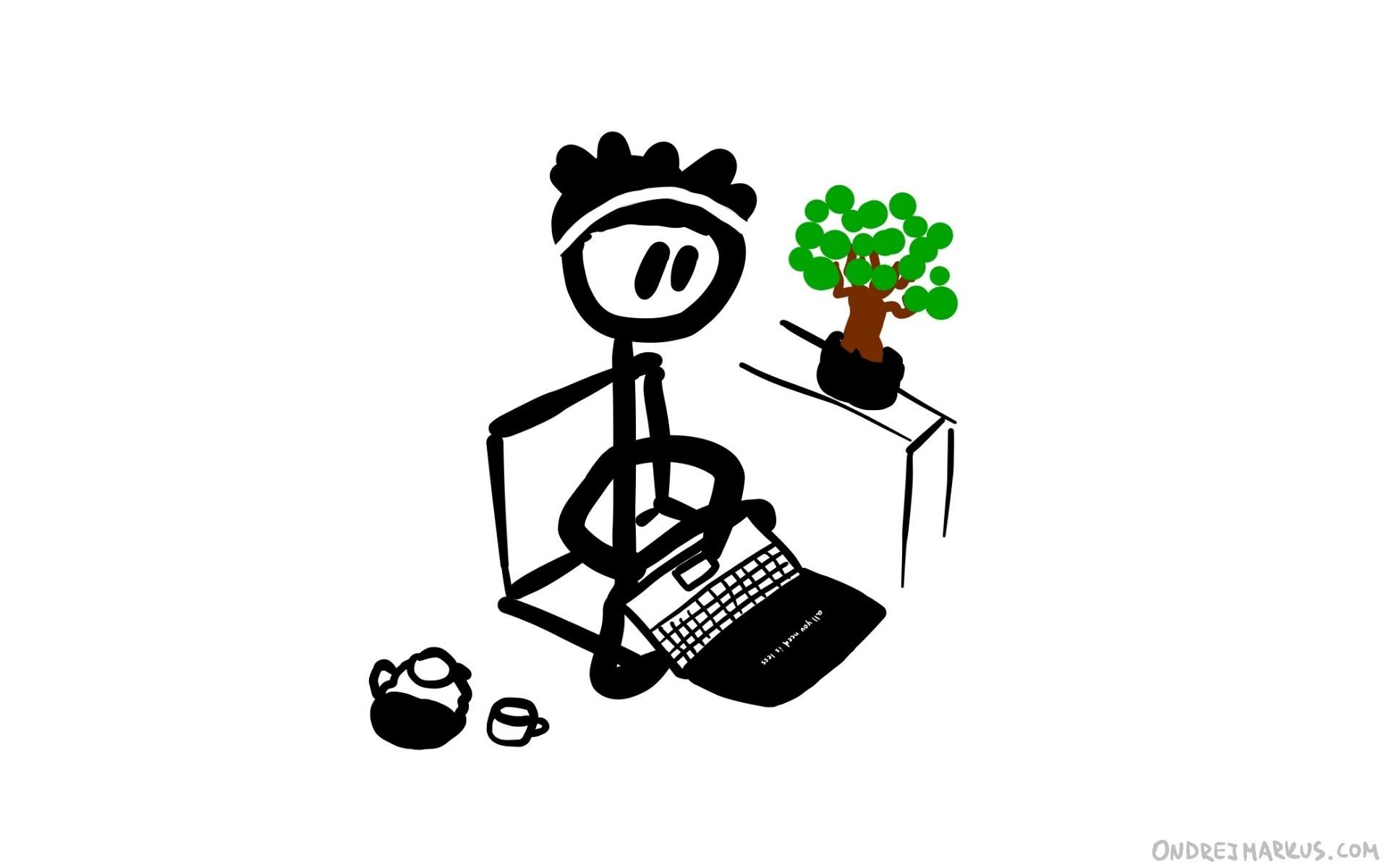

Hey there. 👋
Work happened in February and I have a restless need to talk about it.
This is the first time I include everything from my work-life. I talk about projects I previously left out to keep my online writing separate from my “day jobs”.
But seeing how my projects influenced each other during this month, I realized, I can’t write this without mentioning all of them.
What’s inside
There is a story behind the order of these 5 parts, but feel free to skip to whatever seems like your kind of thing.
Enjoy.
Last month, I committed to finishing 14 fiction stories in any shape or form, because I wanted to practice storytelling as a tool for communication.
I believe telling engaging stories is a superpower. It’s probably the most effective way of spreading ideas. People love a good story.
And it’s not complicated to do so: Create two characters and let them disagree about anything you want to make a point about. You have a conflict, and conflict is a story.
Anyway, back to why my fascination with stories wasn’t enough to make me finish 14 of them in one month.
I think my aspiration was destined to fail from the beginning. And it’s because I keep making the same mistake when I set my monthly goals.
My mistake is three-fold:
I make my goals huge (14),
long-term (in a month),
and generic (fiction stories).
Goals like this one rarely work for me. Yet I keep making them for some reason. Maybe I do it for the epic feeling when I pledge to them and I think: “Fuck yeeeah, I’ll push myself and I’m gonna get this shit DONE!”
Then, in a week, I’m furious with my past self: “Why did you do this to me?! Again. This was a terrible idea, and I regret it already.”
But I found a solution. Maybe. I hope. And I’m going to talk about it in detail later.
However, let me get back to getting back to the point, and report what I did and didn’t do when it comes to writing those 14 fiction stories.
I’m sad to admit that even though I’ve put in over 30 hours of work in the first 2 weeks of February, I wasn’t able to finish more than 1 short script and 3 short comics.
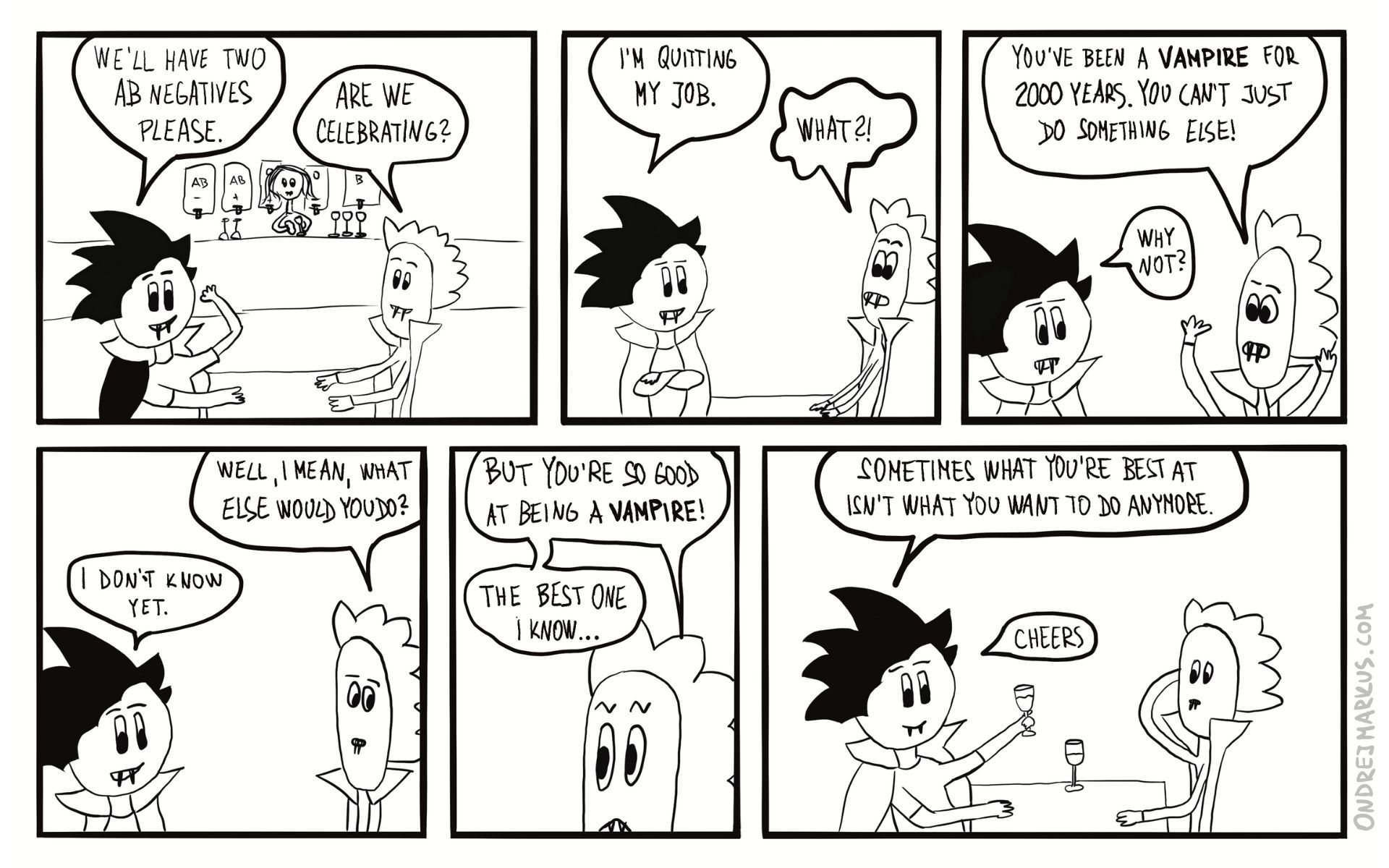
I couldn’t bring myself to coloring it.
That doesn’t mean I haven’t started other things – oooh I did – but I couldn’t get myself to finish them. Because finishing is hard.
I started but dropped 5+ other short stories, scripts, and comics, which I decided at some point I don’t want to work on anymore.
Still, even though I didn’t finish as many stories as I aspired to, I learned a priceless lesson of storytelling I want to share with you:
Creating compelling characters is the most powerful weapon of storytelling. It’s our human nature to be interested in other people (characters), however fictional they are, as long as they feel real.
It’s going back to the “two characters disagreeing about anything” example: If you can make interesting characters and put wisdom and whimsy in their brains and mouths, you’ve got a winner.
Also, character creation and writing fiction proved unexpectedly useful for another project I was working on. And I’m still surprised about how much better the thing became once I wrote a character for it.
I’m a part of a team that’s working on a web application that measures the wellbeing of people in companies. We use a chatbot to collect data in their Slack or MS Teams and it asks the employees some simple questions.
And we struggled with the problem of how to make the experience more engaging? Because answering automatically generated questions is boring.
In reaction to this pickle, my fiction fascination prompted me to write a character for our chatbot. I hoped that it would make the interactions more fun and therefore lead to higher response rates. I mean, in my head, it’s more enjoyable to talk to a bot who makes unexpected jokes about being a robot.
Bot dialog example:
Thank you for helping me do my job. At least my colegues won’t dissamble me for parts to build a toaster instead. ⚙️
Haha. It’s funny because I don’t have any body parts.
Anyway, where were we?
We have 12 questions left. Will you continue saving my imaginary body now, or tomorrow?
Also, my human makers will give me cyber-candy. 🍬
But the dialog I wrote for the bot was just a tip of a personality iceberg. I went bananas and wrote a detailed personality backstory with more information than anyone ever needs to know about the bot.
The point of doing this was to create a character who has a consistent personality and therefore feels alive. She has a particular sense of humor, insecurities, and goals. Also, I gave her some weirdly specific hobbies like VR gardening or being an avid rights activist for AI and robot rights.
Say hello to Green.
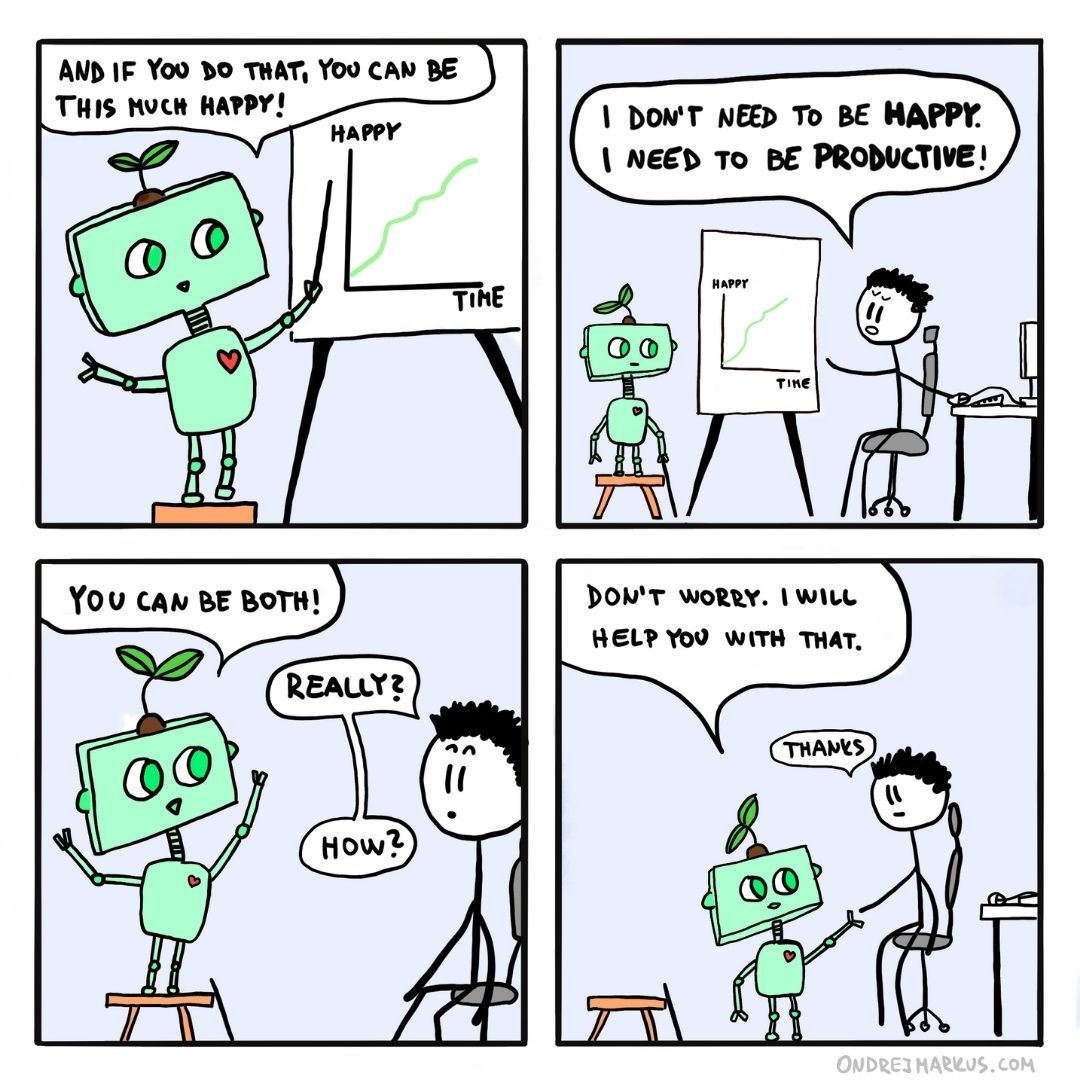
Green meets humans #1
This operation was an experiment on my part. I didn’t know what my team will think about it, or what the clients would say. However, the team liked it, so we launched Green in one company and the people talking to the bot loved her. They complimented the jokes, and the response rate was higher than we expected.
It’s just one test. But it looks promising. So I’m working on improvements and we’ll test with another client soon.
Another project I haven’t mentioned before is co-creating the Innovation lab.
It’s a practical seminar at the Charles University in Prague, and it guides students through the experience of building a project from scratch. (And it’s completely online these days, of course).
There are two of us: Jan Veselý, a friend and the original author who founded the Innovation lab 3 years ago and has done six runs so far. I joined him in the last 2 runs.
And this semester began with an exciting but scary surprise. 50 students signed up. That’s much more than we were expecting, or were prepared for – to be honest.
The thing is, in the previous semesters, there were 10 to 15 students who haven’t dropped after they’ve realized there is some real work to be done. Now it’s 50, and 50 is a whole different game than 10.
This means we had two challenges to deal with:
completely re-think the structure,
facilitate 50 people into teams.
The previous two semesters also ran completely online. But with fewer students, we depended on personal consultations. Specifically, all of us came together once a week for a 2-hour Zoom, and every team had 15 to 30 minutes to show their progress, say what they need to solve, and get help from us or each other. And it worked.
But this is not an option with 50 students and limited time. So we chose a different way. We did some research on running cohort-based online courses like ours and found a thought-provoking insight that challenged our original beliefs.
Since everything moved online, we depended on an unguided approach to teaching. That means we gave students links to some material they could use, but otherwise, we let them figure things out for themselves.
However, there is research indicating that unguided methods don’t work very well for beginners. The unguided approach works best once the students are advanced enough to (at least somewhat) know what to do.
We speculated that this might be one reason why the drop-out rate in the previous semesters was relatively high: That once unguided students didn’t know what to do next, they quit.
So we decided to make the experience more structured in the first 4 sessions out of 13, and only then switch to an unguided approach, which we still believe has its own advantages.
These 4 sessions are designed as an introduction to creating any product or service. And it doesn’t matter whether it’s developing an app, building a course, or starting a podcast. It’s made of the basic principles, tools, and mindsets, that are useful to anyone who wants to build something from nothing.
We talk about how to choose and define your target group, how to talk to your customers and understand their needs and problems, how to build prototypes and use them for early testing, and other things like that.
After this 4-part module that should offer students enough guidance to get their projects rolling, we switch to a relatively unguided structure. There will be weekly check-ins, feedback sessions between teams, and on-demand consultations about specific issues with Honza and me.
As I’m writing this, it’s the end of the third week, so things are still shaping and not 100% set in stone. We learn and iterate as we go.
The second challenge here was that every student enters the seminar in a different position.
Some people come in a team that’s already working on a project. That’s easy. Although, some people have a team but no project. Other people have an idea for a project but no team. And some have neither and look for a team to join.
Of course, additionally, everyone has their own preferences not just for the kind of project they want to do, but the kind of people they want to work with.
So the teaming phase always feels like something out of our control. It’s more like some kind of chaotic magic that just happens on spot. Some people are left out, but most find their way into a team.
But this semester we took things to a different level. We wanted to eliminate the high drop-out rate. So we’ve dedicated extra hours to make a dashboard with every single student, their team, and project, to know who might need assistance. And then I contacted them 1 on 1 to offer help with finding a team.
This personal approach seems to be working, and it wasn’t as time-consuming as I feared it would be. We have only 2 drop-outs after 3 weeks which is much less than we’ve expected. Noice.
Having 50 students signed up for the Innovation lab got me hyped. I want to get really good at doing live online courses.
Also, I’ve done a lot of research on cohort-based learning, so I’m tempted to do something with this know-how that’s brewing in my brain.
And I’m not completely new to this area either. I ran a 4-week live workshop in the summer of 2019 called MetaSprint (it’s dead now), and I’m considering a resurrection of that in the online sphere.
I’m seriously tempted to do so because it would solve 2 of my most urgent first-world problems:
And I also believe the best way to learn about courses is to make them. Which is true for anything, really. If you want to get good at something, do it. Or even better, teach it.
It doesn’t matter what they do as long as they are makers with a maker mindset. In other words, they want to make useful things, or even better, they can’t NOT make useful things.
Right now, I have a few friends who do work like this (hello 👋). We give each other feedback, inspiration, and support on a weekly to monthly basis. But it’s not enough for me. I like the idea of forming a larger group where there is always someone ready to give you feedback or point you to helpful resources on the topic you’re currently grappling with. So why not start one?
I’ve sketched out a prototype website to think out loud in public.
I tried to express the idea in just a few words and no time. It’s highly experimental and unfinished, but I put it online to get ideas and feedback. (Almost even before I know what it’s going to be.)
Have a peek at the website, and let me know: What do you think?
Remember when I said earlier that my goal setting doesn’t work and that I found a solution but will talk about it later? Well, now is the later.
First, what I mean when I say my productivity System?
To me, it’s the supporting infrastructure made of rules, routines, and tools designed to make my life better.
Full confession: I’m a systems nerd. I enjoy digging deep into why and how to make systems for simplifying life and getting things done. I can’t help myself. It’s one of those things I keep experimenting with all the time, and one of the topics I could talk about for hours. Anytime. Anywhere.
Anyhow, back to the issue. I realized I have a problem in the middle of the month when I looked at my goals, and there it was at the top: “Finish 14 fiction stories”. And I thought “I’m neither really doing that, nor do I think it’s what I should or want to do now”.
In different words, my priorities changed but my goals remained static. And the goals were screaming for attention by hurling guilt at me: “You said in public you’re going to finish this. Are you a quitter? Are you lazy? You can’t do it, can you?”.
“Shutuuuup!” The voice is annoying. Do you have it too? Anyway. Where were we?
Oh yeah. This helped me understand that the way I’m setting goals for myself doesn’t work. I needed to make changes.
And now, if I had to leap forward and summarize everything I’ve changed into one sentence for you to spare you of the systems nerdiness, it would be this:
I’ll explain. (#NerdAlert)
I need projects to function as a human being. Everything works better when my life is organized in concrete projects instead of goals.
To make things clear: I define a project as a set of tasks with a deadline leading to a specific outcome.
For example, a project might be to: “Create a web prototype for MetaSprint #2”, or “Write and publish What the work happened in February”.
I’m planning to use this form of projects instead of broad goals like “Finish 14 fiction stories” which is a type of goal I usually dream up right out of wishing well at the beginning of the month.
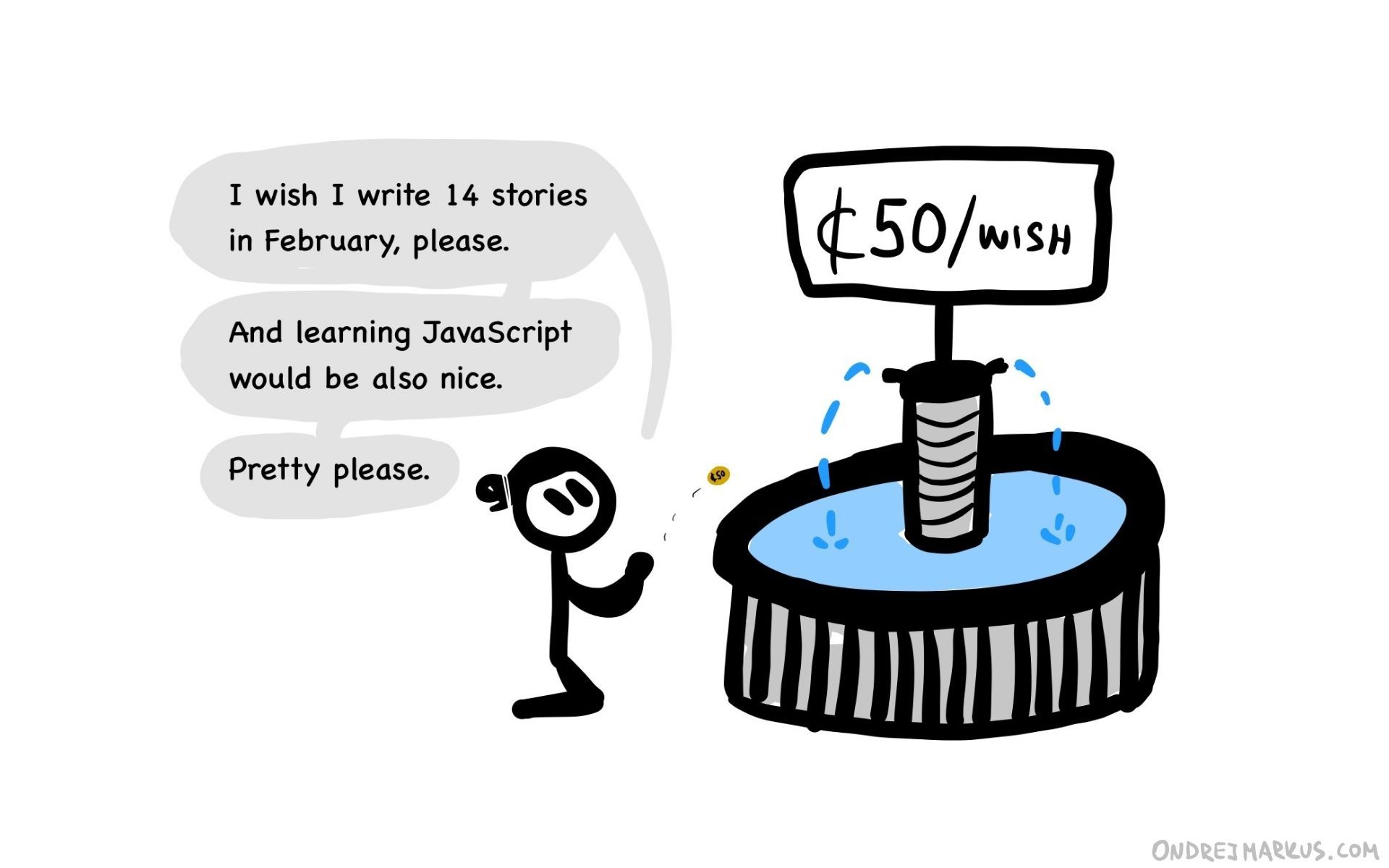
Goal wishing well
These goals don’t work for me when I explore new things. And that’s an important part. I think goals like this are useful when you aim for consistency and you want to make a long-term commitment.
But that’s not what I’m going for at the moment. I need adaptability. I’m primarily in the exploring mode right now, and that brings a lot of sudden changes of directions.
Although, even after that changes and I’ll maybe want to go deeper into one thing, I will use projects as the main building block of my system. Because projects are more actionable. They’re specific.
And I’ve talked before about how I learn much better when I work on a concrete project I am excited to finish, instead of just following instructions of a video-course or something like that. I need projects to make meaningful progress on anything. It’s just better in every case I can think of.
So I’ll push things a little into the extreme and make a rule: I can’t work on anything until it’s a project.
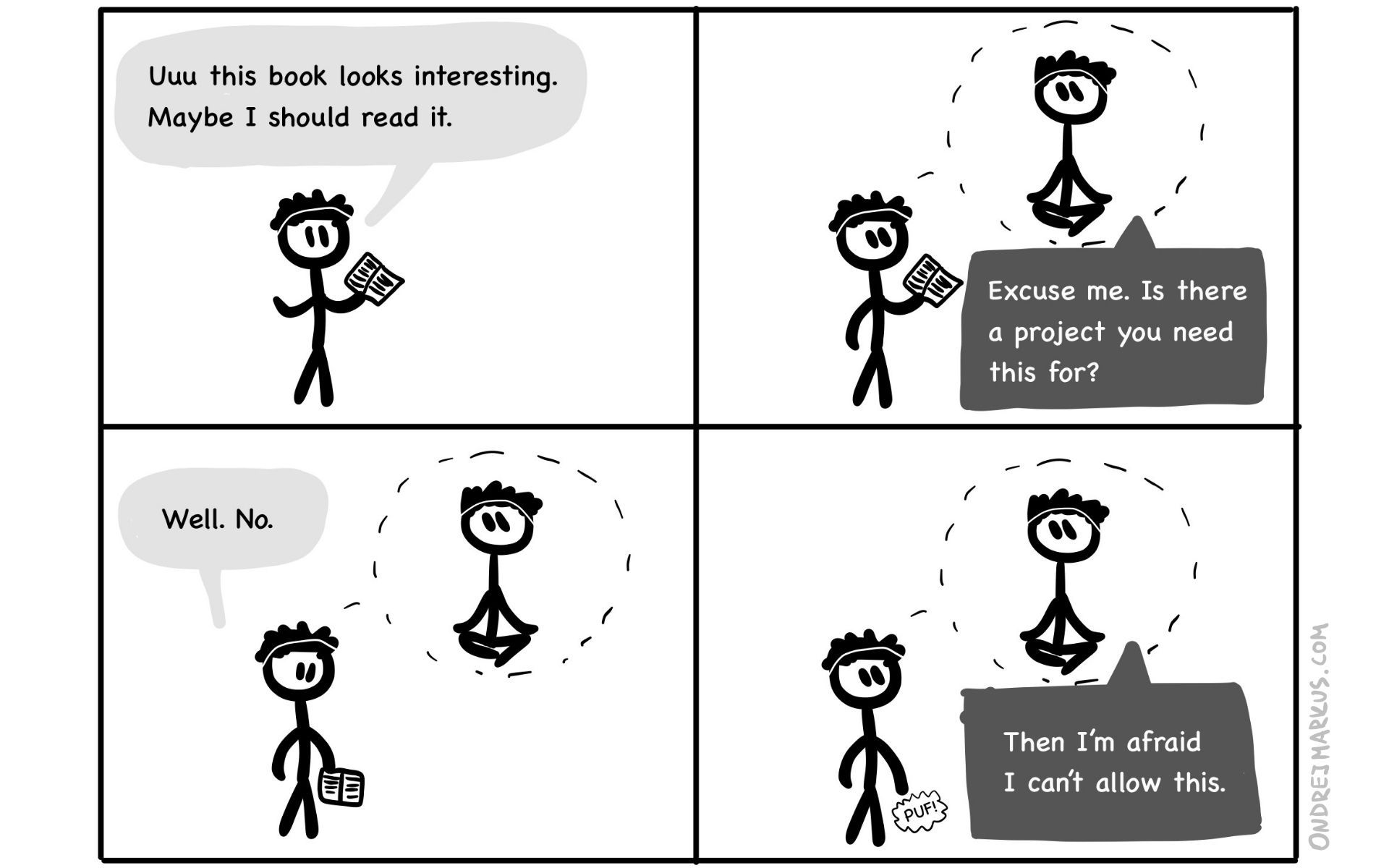
Project or nothing.
The purpose of that is to finally remember and internalize this truth which I keep rediscovering and forgetting every couple of months. It’s freakin' ridiculous watching myself going in circles like that.
By the way, that’s one reason why I write these reflections – to catch myself doing non-sense like this. And hopefully to help you avoid it altogether.
I think the main reason projects work for me is that they sharpen my focus. When I have a few active projects written down and present at the back of my mind, anything I encounter gets filtered for relevance to one of those projects. If it’s irrelevant I can ignore it.
There is too much information these days and having something to filter them against is crucial because everything looks so interesting and useful. A thousand books on the to-read list. A million educational Youtube videos on my to-watch list. It’s impossible to pay attention to everything.
Without projects, whatever random interest pops up, I go and do “research”. And sure, sometimes I find something good that leads to other things. But most of the time, it’s aimless wandering that leaves me with a bitter feeling of wasted time. Nothing really happens. Nothing gets done.
A good project helps me focus on what matters because I can take immediate action on it. There is always a clear next step I can do. It functions as a lens to what is important.
The goals are dead. Long live the projects.
That’s it.
Wow. I’m honored if you read the whole thing. It’s looong. If not though, that’s totally okay too. I hope you enjoyed at least some of it.
I’ll gladly elaborate on anything you want to talk about in an email. Let’s nerd out on things. Shall we?
Also, let me know how was your February. I’m curious what you’re up to and how you’re doing.
Have a good one.
O.